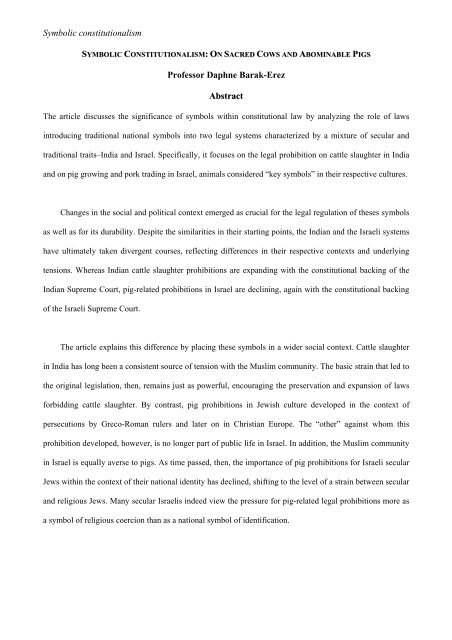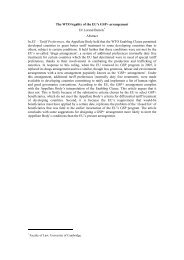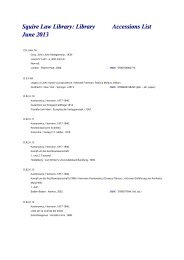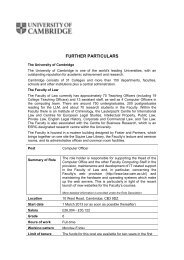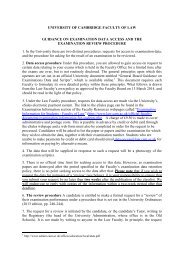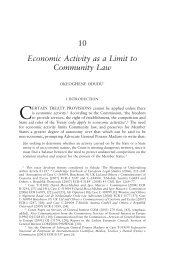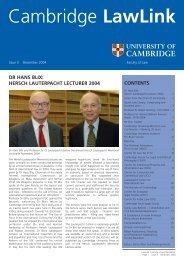Symbolic Constitutionalism: On Sacred Cows and Abominable Pigs
Symbolic Constitutionalism: On Sacred Cows and Abominable Pigs
Symbolic Constitutionalism: On Sacred Cows and Abominable Pigs
Create successful ePaper yourself
Turn your PDF publications into a flip-book with our unique Google optimized e-Paper software.
<strong>Symbolic</strong> constitutionalism<br />
SYMBOLIC CONSTITUTIONALISM: ON SACRED COWS AND ABOMINABLE PIGS<br />
Professor Daphne Barak-Erez<br />
Abstract<br />
The article discusses the significance of symbols within constitutional law by analyzing the role of laws<br />
introducing traditional national symbols into two legal systems characterized by a mixture of secular <strong>and</strong><br />
traditional traits–India <strong>and</strong> Israel. Specifically, it focuses on the legal prohibition on cattle slaughter in India<br />
<strong>and</strong> on pig growing <strong>and</strong> pork trading in Israel, animals considered “key symbols” in their respective cultures.<br />
Changes in the social <strong>and</strong> political context emerged as crucial for the legal regulation of theses symbols<br />
as well as for its durability. Despite the similarities in their starting points, the Indian <strong>and</strong> the Israeli systems<br />
have ultimately taken divergent courses, reflecting differences in their respective contexts <strong>and</strong> underlying<br />
tensions. Whereas Indian cattle slaughter prohibitions are exp<strong>and</strong>ing with the constitutional backing of the<br />
Indian Supreme Court, pig-related prohibitions in Israel are declining, again with the constitutional backing<br />
of the Israeli Supreme Court.<br />
The article explains this difference by placing these symbols in a wider social context. Cattle slaughter<br />
in India has long been a consistent source of tension with the Muslim community. The basic strain that led to<br />
the original legislation, then, remains just as powerful, encouraging the preservation <strong>and</strong> expansion of laws<br />
forbidding cattle slaughter. By contrast, pig prohibitions in Jewish culture developed in the context of<br />
persecutions by Greco-Roman rulers <strong>and</strong> later on in Christian Europe. The “other” against whom this<br />
prohibition developed, however, is no longer part of public life in Israel. In addition, the Muslim community<br />
in Israel is equally averse to pigs. As time passed, then, the importance of pig prohibitions for Israeli secular<br />
Jews within the context of their national identity has declined, shifting to the level of a strain between secular<br />
<strong>and</strong> religious Jews. Many secular Israelis indeed view the pressure for pig-related legal prohibitions more as<br />
a symbol of religious coercion than as a national symbol of identification.
<strong>Symbolic</strong> <strong>Constitutionalism</strong><br />
A. Symbols <strong>and</strong> Constitutional Law<br />
B. <strong>Sacred</strong> <strong>Cows</strong> <strong>and</strong> <strong>Abominable</strong> <strong>Pigs</strong>: The Cultural Background<br />
(1) <strong>Cows</strong> in Hindu Culture<br />
(2) <strong>Pigs</strong> in Jewish Culture<br />
C. Laying the Foundations: From Tradition to Legislation <strong>and</strong> Constitution-Making<br />
(1) The Compromise in the Indian Constitution<br />
(2) The Compromise in Israeli Legislation<br />
D. Formative Litigation<br />
(1) Constitutional Review <strong>and</strong> Limitations on the Prohibition in India<br />
(2) Judicial Decision-Making in the Shadow of Legislative Sovereignty in Israel<br />
E. New Challenges to Old Norms<br />
(1) The Reemergence of the Prohibition on Cattle Slaughter in India<br />
(2) The Decline of Pig Prohibitions in Israel<br />
F. Considering the Differences: Majority-Minority Tensions vis-à-vis Tensions within<br />
the Majority<br />
A. Symbols <strong>and</strong> Constitutional Law<br />
Legal norms at times reflect symbols. Legislation protecting national flags is an obvious example. 1 This<br />
article discusses the significance of symbols within the context of constitutional law by analyzing the role of<br />
laws introducing traditional national symbols into two legal systems characterized by a mixture of secular<br />
<strong>and</strong> traditional traits – India <strong>and</strong> Israel. 2 Specifically, it focuses on the legal prohibition on cattle slaughter in<br />
India <strong>and</strong> on pig growing <strong>and</strong> pork trading in Israel, animals considered “key symbols” in their respective<br />
cultures. 3 My starting assumption in this discussion is that symbols are significant, in the sense developed by<br />
Clifford Geertz: 4<br />
But meanings can only be “stored” in symbols: a cross, a crescent, or a feathered serpent. Such religious<br />
symbols, dramatized in rituals or related in myths, are felt somehow to sum up, for those for whom they<br />
are resonant, what is known about the way the world is, the quality of the emotional life it supports, <strong>and</strong><br />
the way one ought to behave while in it. <strong>Sacred</strong> symbols thus relate an ontology <strong>and</strong> cosmology to an<br />
aesthetics <strong>and</strong> a morality: Their peculiar power comes from their presumed ability to identify fact with<br />
value at the most fundamental level, to give to what is otherwise merely actual, a comprehensive<br />
normative import. The number of such synthesizing symbols is limited in any culture, <strong>and</strong> though we<br />
might think that a people could construct a wholly autonomous value system independent of any<br />
metaphysical referent, an ethics without ontology, we do not in fact seem to have found such a people. 5<br />
The analysis is inspired by the growing interest in the relationship between law <strong>and</strong> culture. The cultural<br />
study of law shows that legal controversies <strong>and</strong> legal reasoning often reflect underlying cultural perceptions. 6<br />
1 The flag was referred to as “the visible symbol embodying the Nation.” Texas v. Johnson 491 U.S. 397, 429 (1989)<br />
(Chief Justice Renquist, dissenting).<br />
2 For a comparative discussion of secularism in India <strong>and</strong> Israel, see Gary Jeffrey Jacobson, The Wheel of Law: India’s<br />
Secularism in Comparative Constitutional Context (2003) 72-89.<br />
3 See: Sherry Ortner “<strong>On</strong> Key Symbols” 75 American Anthropologist 1338 (1973). A well-known book by Marvin<br />
Harris refers to these two symbols in a way that inspired the title of this article. See: Marvin Harris The <strong>Sacred</strong> Cow <strong>and</strong><br />
the <strong>Abominable</strong> Pig: Riddles of Food <strong>and</strong> Culture (1985).<br />
4 Clifford Geertz, The Interpretation of Cultures (1973), ch. 5, “Ethos, World View, <strong>and</strong> the Analysis of <strong>Sacred</strong><br />
Symbols,” pp. 126-141.<br />
5 Id., at p. 127. The halakhic discussion on the symbolic aspect of the comm<strong>and</strong>ments makes for an interesting<br />
comparison. See Rabbi Samson Raphael Hirsh, The Comm<strong>and</strong>ments as Symbols (tr. from German Aviazri Wolf, 1984)<br />
[Hebrew]. This book does not include a symbolic analysis of all 613 halakhic comm<strong>and</strong>ments but refers to several<br />
examples that provide a basis for discussion, such as circumcision, tsitsit [fringed garment], tefillin [phylacteries], <strong>and</strong><br />
the Temple <strong>and</strong> its utensils.<br />
6 See, for instance: Ronen Shamir “Suspended in Space: Bedouins in Israeli Law” 30 L. & Soc. Rev. 231 (1996).<br />
2
<strong>Symbolic</strong> <strong>Constitutionalism</strong><br />
The cultural study of law is of particular interest in this context because it focuses on communities, 7 <strong>and</strong> the<br />
symbols to be addressed are symbols of cultural communities. This article takes into consideration the<br />
symbolic function of legal norms <strong>and</strong> looks into the implications of affirming symbols through law. 8 As<br />
Joseph Gusfield notes, “The fact of affirmation through acts of law <strong>and</strong> government expresses the public<br />
worth of one set of norms, of one sub-culture vis-à-vis those of others. It demonstrates which cultures have<br />
legitimacy <strong>and</strong> public domination, <strong>and</strong> which do not.” 9<br />
The two case studies chosen for analysis show close resemblances: both rest on symbols fundamental to<br />
their respective domestic cultures, both symbolic systems have religious roots but are also significant within<br />
the wider context of the national culture, <strong>and</strong> both have implications for individual liberties. Accordingly, the<br />
introduction of these symbols into law was part of the constitutional debate in India as well as in Israel. The<br />
article traces the course of these symbolic norms in both countries since their independence <strong>and</strong> until today,<br />
highlighting similarities <strong>and</strong> differences. The analysis reveals that changes in the underlying social <strong>and</strong><br />
political context are crucial to the legal regulation of symbols in general <strong>and</strong> to their durability in particular.<br />
B. <strong>Sacred</strong> <strong>Cows</strong> <strong>and</strong> <strong>Abominable</strong> <strong>Pigs</strong>: The Cultural Background<br />
(1) <strong>Cows</strong> in Hindu Culture<br />
The sacredness of the cow in India dates back thous<strong>and</strong>s of years. It is expressed in Hindu mythology <strong>and</strong><br />
significantly related to the worship of Krishna. The cow is often referred to as “mother” <strong>and</strong> as the source of<br />
life. 10 Over the years, cows have also acquired national significance. The slaughter of cattle is engraved in<br />
Indian national memory as associated with national oppression, at first by Muslim conquerors <strong>and</strong> later by<br />
the British. 11 Cattle slaughter served as a constant source of unrest in colonial India <strong>and</strong>, as Indian<br />
nationalism gained increasing power, initiatives aimed at the protection of cattle gradually accumulated<br />
7 Paul W. Kahn The Cultural Study of Law (1999) 112: “the object of cultural study is the community in its appearance<br />
as single, historical subject.”<br />
8 Another example that may merit similar discussion is the placing of crosses in public places. <strong>On</strong> the German approach,<br />
see: Crucifix in the Classrooms Decision BverfGE 1 (1995), as discussed by Sabine Michalowski <strong>and</strong> Lorna Woods,<br />
German Constitutional Law: The Protection of Civil Liberties (1999) 187-191. <strong>On</strong> the American approach, see: County<br />
of Allegheny v. American Civil Liberties Union, Greater Pittsburgh Chapter 492 U.S. 573 (1989). In the United States,<br />
controversies in this area centered on the constitutional prohibition on the establishment of religion, which applies also<br />
to the adoption or promotion of religious symbols by the government. See also: Janet L. Dolgin “Religious Symbols <strong>and</strong><br />
the Establishment of a National ‘Religion’” 39 Mercer L. Rev. 495 (1987-88); Kenneth L. Karst “The First Amendment,<br />
The Politics of Religion <strong>and</strong> the Symbols of Government” 27 Harv. C. R. – C. L. L. Rev. 503 (1992). A counter example<br />
with obvious symbolic significance concerns acts thought to offend religious feelings by desecrating symbols. <strong>On</strong> the<br />
dispute around the display of the picture Piss Christ, see: Damien Casey “Law <strong>and</strong> the <strong>Sacred</strong>: Sacrifice, Piss Christ,<br />
<strong>and</strong> Liberal Excess” 5 Law/Text/Culture 19 (2000); Michael Casey, Anthony Fisher <strong>and</strong> Hayden Ramsay, “Law <strong>and</strong> the<br />
<strong>Sacred</strong>: After Serrano Ethics, Theology <strong>and</strong> the Law of Blasphemy” 5 Law/Text/Culture 35 (2000); Damien Casey<br />
“Law & The <strong>Sacred</strong>: After Serrano Sacrifice <strong>and</strong> Church Politics” 5 Law/Text/Culture 55 (2000). A non-religious<br />
symbol that was discussed in relation to its desecration is the American national flag, “the visible symbol embodying<br />
the Nation.” Texas v. Johnson 491 U.S. 397, 429 (1989) (Chief Justice Renquist, dissenting). See also: Ute Krudewagen<br />
“Political Symbols in Two Constitutional Orders: The Flag Desecration Decisions of the United States Supreme Court<br />
<strong>and</strong> the German Constitutional Court” 19 Ariz .J. Int’l & Comp. L. 679 (2002).<br />
9 See: Joseph R. Gusfield “Moral Passage: The <strong>Symbolic</strong> Process in Public Designations of Deviance” 15 Social<br />
Problems 175, 178 (1967). At the same time, it has been argued that legislating symbols makes them less effective for<br />
the purpose of identifying their supporters as group members because, when backed by the force of law, symbols may<br />
also gain the respect of non-members. See: Eric A. Posner “Symbols, Signals, <strong>and</strong> Social Norms in Politics <strong>and</strong> Law”<br />
27 J. Legal Studies 765 (1998). The article focuses on the function of the symbol as a signal through which the players<br />
express their loyalty to the community.<br />
10 For a detailed background, see: Report of the National Commission on Cattle (July, 2002) (hereinafter: National<br />
Cattle Report), Chapter 1.<br />
11 According to the National Cattle Report: “Cow slaughter in India first started around 1000 A.D. when various Islamic<br />
invaders came to this country from Turkey, Iran (Persia), Arabia <strong>and</strong> Afgahnistan… When the invaders came to India,<br />
they started sacrificing cows, especially on the occasion of Bakri-Id. This was done more to humiliate the natives of this<br />
country <strong>and</strong> establish their sovereignty <strong>and</strong> superiority rather than for food purposes.” Ibid., Chapter 1, para. 25.<br />
3
<strong>Symbolic</strong> <strong>Constitutionalism</strong><br />
support. 12 These initiatives were often mixed with anti-Muslim sentiments: their insistence on beef-eating<br />
was perceived as a deliberate affront. 13 Mahatma G<strong>and</strong>hi, who led the Indian national movement, was<br />
strongly identified with the protests against cow-killing. 14<br />
(2) <strong>Pigs</strong> in Jewish Culture<br />
The abomination of pigs in Jewish culture is also an ancient <strong>and</strong> deeply entrenched tradition. The prohibition<br />
on pigs originates in the Bible 15 but gained significance later on, when it was used as a tool for persecuting<br />
Jews in the Greco-Roman world as well as in Christian Europe. For centuries, stories about the self-sacrifice<br />
<strong>and</strong> devotion of Jews who refused to abide orders to eat pork have served as educational examples. The<br />
leading legend is that of Hannah <strong>and</strong> her seven sons, who were martyred for their refusal to eat pork. 16 The<br />
anthropologist Mary Douglas considered these persecutions during the reign of Antiochus Epiphanes, the<br />
Hellenistic king, a turning point that bestowed upon the pig its special symbolic status in Jewish culture.<br />
Referring to these persecutions, she states: “So it was he, by his action, who forced into prominence the rule<br />
concerning pork as the critical symbol of group allegiance.” 17 The significance of the Jews’ revulsion from<br />
pigs persisted in Christian Europe, where it gained a special status in anti-Semitic tradition. 18<br />
When Jews began to establish a political community in Israel, initiatives were promoted to ensure the<br />
presence of traditional Jewish symbols. The historical revulsion at pigs was certainly considered in this<br />
respect, but as long as Palestine was under British rule (as was India), the scope for such national sentiments<br />
was limited <strong>and</strong> channeled mainly into local initiatives to appeal to the British authorities. 19<br />
C. Laying the Foundations:<br />
From Tradition to Legislation <strong>and</strong> Constitution-Making<br />
Despite the obvious differences between them, the similarities between India <strong>and</strong> Israel justify a comparative<br />
analysis. Both countries proclaimed their independence during the same period, India in 1947 <strong>and</strong> Israel in<br />
1948, at the end of British colonialism. Both shared an aspiration to establish modern democracies, both<br />
sought to preserve their ties with their respective ancestral cultures, <strong>and</strong> both were home to a multicultural<br />
population. More specifically, both India <strong>and</strong> Israel faced a similar problem: to what extent would their<br />
respective legal systems adhere to tradition as part of the project of nation-building.<br />
12 See: Therese O’Toole “Secularizing the <strong>Sacred</strong> Cow: The Relationship between Religious Reform <strong>and</strong> Hindu<br />
Nationalism” Hinduism in Public <strong>and</strong> Private: Reform. Hintutva, Gender <strong>and</strong> Sampraday (Oxford <strong>and</strong> New York;<br />
Oxford University Press, ed. Anthony Copley, 2003) 84.<br />
13 The Qur’an, trans. M.A.S. Abdel Haleem (Oxford: Oxford University Press, 2004), ch. 5, “The Feast,” para. 3, p. 67;<br />
ch. 16, “The Bee,” para. 115, pp. 173.<br />
14 National Cattle Report, supra note 10, Chapter 1, para. 34. For further background, see: Frederick J. Simoons<br />
“Questions in the <strong>Sacred</strong>-Cow Controversy” 20 Current Anthropology 467 (1979); Deryck Lodrick “Symbol <strong>and</strong><br />
Sustenance: Cattle in South Asian Culture” 29 Dialectical Anthropology 61 (2005).<br />
15 “And the swine, though he divide the hoof, <strong>and</strong> be cloven-footed, yet he chews not the cud; he is unclean to you. Of<br />
their flesh shall you not eat, <strong>and</strong> their carcass shall you not touch; they are unclean to you” (Leviticus 11:7-8); “And the<br />
swine, because it divides the hoof, yet chews not the cud, is unclean unto you: you shall not eat of their meat, nor touch<br />
their carcasses” (Deuteronomy 14:8).<br />
16 For a full account, see: The Book of Maccabees, tr.. Jonathan A. Goldstein (1981), 1:1-47, 206.<br />
17 Mary Douglas Natural Symbols (New York: Routledge, 1996) 40. For more details, see: Daphne Barak-Erez<br />
Outlawed <strong>Pigs</strong> (Madison: University of Wisconsin Press, 2007), Chapter 2.<br />
18 Claudine Fabre-Vassas The Singular Beast: Jews, Christians, <strong>and</strong> the Pig, tr. Carol Volk (New York: Columbia<br />
University Press, 1997).<br />
19 For instance, Tel Aviv city councilor David Zvi Pinkas raised a motion in 1944 concerning the transport of pork<br />
within city precincts. In response, he was told that the matter would be brought before the High Commissioner. See:<br />
Gazette of the Tel Aviv Municipality, fourteenth year, Elul 5704-Tishrei 5705 (1940-1945), issues 5-6, at p. 62<br />
[Hebrew].<br />
4
<strong>Symbolic</strong> <strong>Constitutionalism</strong><br />
The challenges of balancing between secularism <strong>and</strong> tradition obviously did not focus only, or even<br />
mainly, on the issue of cows in India <strong>and</strong> pigs in Israel. 20 They had inspired controversies in other areas<br />
regulated by law, as well as constitutional documents. 21 Accordingly, the following discussion addresses the<br />
case study of cattle slaughter prohibitions <strong>and</strong> pigs related prohibitions as a microcosm reflecting broader<br />
tensions.<br />
(1) The Compromise in the Indian Constitution<br />
India introduced a norm affirming the cultural prohibition on cattle slaughter from the outset by integrating it<br />
into its constitution. Article 48 of the Indian Constitution, considered one of the Constitution’s Directive<br />
Principles of State Policy, requires the adoption of measures prohibiting the slaughter of cattle: “The State<br />
shall endeavor to organize agriculture <strong>and</strong> animal husb<strong>and</strong>ry on modern <strong>and</strong> scientific lines <strong>and</strong> shall, in<br />
particular, take steps for preserving <strong>and</strong> improving the breeds, <strong>and</strong> prohibiting the slaughter of cows <strong>and</strong><br />
calves <strong>and</strong> other milk <strong>and</strong> draught cattle.” This provision, inspired by the Hindu tradition that views cows as<br />
holy, was based on strong popular sentiment. The need to ban cow slaughter was debated in the Indian<br />
Constituent Assembly <strong>and</strong> explained by its supporters as not only a religious matter but as a cultural <strong>and</strong><br />
economic interest as well. 22<br />
Although the Indian Constitution affirmed the cultural prohibition, this affirmation entailed a<br />
compromise: the prohibition on cattle slaughter is considered only a directive principle. Accordingly, it only<br />
encourages states to enact laws on this matter. The constitution, then, gave significant backing to the<br />
possibility of legislation in this area but decided to allocate the matter to the states, leaving open the option of<br />
non-legislation, for instance, in Muslim-dominated areas. 23 In practice, many states do have legislation<br />
banning the slaughter of cattle, with certain nuances discussed below.<br />
(2) The Compromise in Israeli Legislation<br />
Contrary to India, the introduction of pig prohibitions into Israeli law was not part of a constitution-writing<br />
project, if only because Israel did not adopt a constitution after its establishment <strong>and</strong> endorsed instead the<br />
British tradition of an unwritten constitution. 24 Accordingly, initiatives to introduce into Israeli law<br />
traditional Jewish prohibitions on pig breeding <strong>and</strong> pork trading were confined to the legislative <strong>and</strong><br />
administrative spheres. Hence, when Israeli courts are asked to review these initiatives, they lack a specific<br />
constitutional norm to guide them on this matter.<br />
20 An important example worth noting is that of family law. Both India <strong>and</strong> Israel opened the door to the application of<br />
their various communities’ religious laws in the area of family law by applying to each individual the law of his or her<br />
religious group. The details of this basic choice, however, are different in the two countries. In Israel, the application of<br />
religious law is focused mainly on marriage <strong>and</strong> divorce. Formally, there is no right of exit from this regulation of<br />
marriage <strong>and</strong> divorce but, in practice, several mechanisms limit the consequences of the basic principle (such as<br />
affording full social <strong>and</strong> economic rights <strong>and</strong> privileges to cohabitants <strong>and</strong> registering civil marriages that took place in<br />
other countries, including so-called Cyprus marriages conducted in the neighboring isl<strong>and</strong> of Cyprus). In India, the<br />
application of family law is also significant in other contexts of family law. Formally, it is possible to opt for a civil<br />
marriage but, in practice, the vast majority of the population does not resort to this option. For a comparative discussion<br />
of India <strong>and</strong> Israel in the context of family law, see: Marc Galanter <strong>and</strong> Jayanth Krishnan “Personal Law <strong>and</strong> Human<br />
Rights in India <strong>and</strong> Israel” 34 Isr. L. Rev. 101 (2000).<br />
21 <strong>On</strong> the constitutional level, Israel has defined itself from the very beginning as a "Jewish state" (in the Declaration of<br />
the Establishment of the State of Israel), <strong>and</strong> later on adopted the "Jewish <strong>and</strong> democratic" formula in its basic laws<br />
(section 2 of Basic Law: Freedom of Occupation; Section 1A of Basic Law: Human Dignity <strong>and</strong> Liberty). In contrast,<br />
according to the preamble of the Indian constitution, India is a "sovereign socialist secular democratic republic".<br />
22 V. P. Bharatiya Religion-State Relationship <strong>and</strong> Constitutional Rights in India (New Delhi: Deep & Deep<br />
Publications, 1987) 210-211; R.I. Chaudhari The Concept of Secularism in Indian Constitution (New Delhi: Uppal Pub.<br />
House, 1987, 1987) 160-161; Kanan Gahrana Right to Freedom of Religion: A Study in India Secularism (International<br />
Academic Publishing, 1992) 131-132.<br />
23 See also: Frederick J. Simoons “The <strong>Sacred</strong> Cow <strong>and</strong> the Constitution of India” 2 Ecology of Food <strong>and</strong> Nutrition 281<br />
(1973).<br />
24 <strong>On</strong> the historical background of this choice, see: Daphne Barak-Erez “From an Unwritten to a Written Constitution:<br />
The Israeli Challenge in American Perspective" 26 Colum. Hum. Rts. L. Rev. 309 (1995).<br />
5
<strong>Symbolic</strong> <strong>Constitutionalism</strong><br />
Nevertheless, after Israel was established, calls appeared in the public <strong>and</strong> political spheres for<br />
legislation that would introduce pig-related prohibitions into Israeli law. After the Supreme Court invalidated<br />
the use of existing administrative powers to promote this ideological cause without express authorization (for<br />
instance, by refusing to grant business licenses), 25 legislation became necessary.<br />
In 1957, the Israeli Knesset enacted its first pig-related law by authorizing local municipalities to<br />
prohibit trade in pork within their limits. 26 This form of legislation calls to mind the Indian approach of a<br />
geographically based regulation. In 1962, however, public sentiment on this matter combined with political<br />
pressure to enact another law that prohibited pig breeding in the whole of Israel, with narrow exceptions for<br />
an area populated mainly by Christians <strong>and</strong> when meant for research purposes in zoos. 27<br />
D. Formative Litigation<br />
(1) Constitutional Review <strong>and</strong> Limitations on the Prohibition in India<br />
Bans on cattle slaughter have gradually been introduced in various states in India, <strong>and</strong> have raised questions<br />
since the very beginning. Given the protection of fundamental freedoms ensured by the Indian constitution,<br />
these laws have been attacked in the Indian Supreme Court.<br />
The basic precedent in this matter was laid down in the petition of Mohd. Hanif Quareshi v. Bihar, 28<br />
filed by Muslim butchers. The petitioners argued that the prohibition on slaughtering cattle infringed their<br />
freedom of occupation as well as their religious customs. The court held that the state is allowed to restrict<br />
fundamental freedoms in order to uphold the Directive Principles of State Policy. A restriction, however,<br />
must be reasonable. Insofar as this petition was based on the right to freedom of religion, however, it was<br />
rejected outright due to the lack of any evidence about cattle slaughtering being a religious duty in Islam. As<br />
for the infringement of freedom of occupation, the court found that the legislation could be considered<br />
reasonable if it addressed cattle yielding milk or used for breeding or work. Yet, <strong>and</strong> as an exception to this<br />
limitation, the court did uphold the total prohibition on the slaughter of cows but not on other cattle. Judicial<br />
review, then, introduced a limited change in the scope of the prohibition, but did clarify that the prohibitions<br />
must meet a test of reasonableness.<br />
Other judicial decisions issued during this period followed this initial precedent <strong>and</strong> approved the same<br />
principles with regard to legislative amendments that had tried to circumvent the limited scope of legal cattle<br />
slaughter recognized by the Court. In these cases as well, the Court upheld its main rulings on the<br />
constitutionality of legislation aimed to place significant restrictions on the slaughter of cattle, <strong>and</strong> the need<br />
to impose age limitations on the total prohibition to exclude cattle that cannot be used for agriculture. 29<br />
(2) Judicial Decision-Making in the Shadow of Legislative Sovereignty in Israel<br />
After the Israeli Knesset passed laws on pig-raising <strong>and</strong> pork trading, prospects for petitions in this matter<br />
were limited for the noted reason—Israel did not have a constitution <strong>and</strong> followed instead the British<br />
tradition of an unwritten constitution based on the assumption of legislative sovereignty. 30 Therefore,<br />
although the Israeli Supreme Court had intervened in administrative decisions aimed at limiting pig-related<br />
25 HC 98, 105/54 Lazarovitz v. Food Controller, 10 P. D. 40; HC 194/54 Axel v. the Mayor, Councilors <strong>and</strong> Residents of<br />
Netanya, 8 P. D. 1524; HC 72/55 Fridi v. Municipality of Tel Aviv, 10 P. D. 734.<br />
26 Local Authorities (Special Enablement) Law, 1956 (hereinafter: Special Enablement Law).<br />
27 The Pig-Raising Prohibition Law, 1962. For further historical background on the processes that led to this legislation,<br />
see: Daphne Barak-Erez, supra note 17, Chapter 4.<br />
28 Mohd. Hanif Quareshi v. Bihar (1959) S. C. R. 629.<br />
29 Abdul Hakim Quraishi v. Bihar (1961) 2 S. C. R. 610. For an analysis of Indian case law, see: Durga Das Basu<br />
Shorter Constitution of India (10 th ed., 1988) 277; H. M. Seervai Constitutional Law of India: A Critical Commentary<br />
(4 th ed.) vol. 1 (1991) 834-838; <strong>and</strong> vol. 2 (1993) 1946-1948; J. N. P<strong>and</strong>ey Constitutional Law of India (39 th ed., 2003)<br />
155; Bharatiya, supra note 21, at pp. 212-214; Chaudhari, supra note 21, at pp. 162-164.<br />
30 HC 8/63 Bazul v. Minister of the Interior, 19 (1) P. D. 337.<br />
6
<strong>Symbolic</strong> <strong>Constitutionalism</strong><br />
activities when they were not backed by legislation, no room was left for any significant decision-making in<br />
this area, besides the interpretation of the relevant legislation. 31<br />
E. New Challenges to Old Norms<br />
The following analysis will focus on developments pertaining to the application of the two legal regimes<br />
described so far—the prohibition on cattle slaughter in India <strong>and</strong> pig-related prohibitions in Israel. Despite<br />
the similarities in their original structure, resting on a compromise, they have ultimately followed different<br />
courses, reflecting the differences in context <strong>and</strong> in the underlying tensions.<br />
(1) The Re-Emergence of the Prohibition on Cattle Slaughter in India<br />
Years after Indian constitutional law had appeared to have reached a balance regarding the scope of cattle<br />
slaughter legislation, the issue re-emerged when attempts were made to broaden it. Tensions centered on the<br />
scope of the prohibitions related to other cattle, besides cows, which are covered by an absolute ban that was<br />
regarded as constitutional even in the fundamental Quareshi precedent.<br />
Tensions can be characterized by growing Hindu pressure to broaden the scope of the prohibiting<br />
legislation, <strong>and</strong> by a steady Muslim resistance manifest in challenges submitted to the courts on this matter.<br />
The processes that culminated in the Indian state of Gujarat can serve as a telling example. Gujarat’s<br />
first law on the matter, dating back to the 1950s, had prohibited the slaughter of cows. In 1979, the law was<br />
amended to include prohibitions on the slaughter of bulls <strong>and</strong> bullocks under the age of fifteen. This<br />
amendment was recognized as constitutional by the Supreme Court of India. 32 In 1994, the law was amended<br />
yet again to broaden the prohibition even further <strong>and</strong> include all cattle indiscriminately, irrespective of age.<br />
This amendment seemed to contradict the old case law holding that the prohibition should be reasonable <strong>and</strong><br />
consider potential agricultural uses of the cattle, which is irrelevant regarding very old animals. Accordingly,<br />
the amendment was struck down by the Supreme Court of Gujarat, but the state appealed this decision. This<br />
matter then became the subject of a new precedent of the Indian Supreme Court on this question, discussed<br />
below.<br />
In a similar manner, Muslims in India have never accepted the status quo concerning the application of<br />
slaughter prohibitions to their religious practices. The dem<strong>and</strong> to allow the use of cows in religious<br />
ceremonies remained in place <strong>and</strong> the annual celebrations of Bakri-Id proved to be a constant source of<br />
unrest, although Muslims elsewhere also use other animals as well, such as sheep, for this purpose. In the<br />
mid-1990s, this practice became the subject of litigation when Hindu citizens in West Bengal submitted<br />
petitions against the policy of giving Muslims exemptions from the prohibition on cow slaughter on the<br />
occasion of Bakri-Id. The petitions were accepted by the Calcutta High Court <strong>and</strong> its judgment was later<br />
affirmed by the Indian Supreme Court when it held that, according to the applicable law, the government was<br />
not authorized to give such exemptions because Muslims are not under a religious duty to bring cow<br />
sacrifices. 33<br />
At about this time, cattle slaughter in India was the subject of an influential report submitted by the<br />
National Committee on Cattle. This report conveys a commitment to broaden <strong>and</strong> enforce legislation banning<br />
cattle slaughtering – based on national <strong>and</strong> agricultural grounds. In its conclusions, the report recommends an<br />
absolute prohibition on the slaughter of cattle, <strong>and</strong> even an amendment to the constitution so as to empower<br />
parliament to enact a countrywide law on the matter. 34 In 2004, the lower house of the Indian legislature led<br />
by the Hindu nationalist Bharatiya Janata Party, adopted a non-binding resolution seeking a national ban on<br />
cow slaughter. 35<br />
31 See, for instance, HC 163/57 Lubin v. Municipality of Tel Aviv-Jaffa, 12 P. D. 1041; FH 13/58 Municipality of Tel<br />
Aviv-Jaffa v. Lubin, 13 P. D. 118.<br />
32 Haji Usmanbhai Qureshi v. State of Gujarat (1986) 3 S.C.C. 12.<br />
33 State of West Bengal v. Ashutosh Lahiri (1995) 1 S.C.C. 189.<br />
34 National Cattle Report, supra note 10, Chapter 7.<br />
35 See: Lodrick, supra note 14, at p. 79.<br />
7
<strong>Symbolic</strong> <strong>Constitutionalism</strong><br />
The most recent amendment of the Gujarat law was ultimately reviewed by the Supreme Court of India<br />
in 2005. 36 The Court decided this sensitive case by a majority ruling that accepted the appeal of the State of<br />
Gujarat <strong>and</strong> held that even the sweeping prohibition that extends to all cattle, irrespective of age <strong>and</strong> kind,<br />
can be considered constitutional. In this decision, the majority justices showed their willingness to depart<br />
from the fundamental precedent in this area issued in the 1950s. Although this decision certainly reflects the<br />
growing Hindu nationalist tensions around the prohibition norm, its rationale did not adduce cultural <strong>and</strong><br />
national explanations <strong>and</strong> argued instead that the Court found that the arguments on the importance of cattle<br />
for various uses, even when old, were convincing. In the Court’s view, the justification for ab<strong>and</strong>oning the<br />
precedent is that developments in science <strong>and</strong> agronomy allow for a different analysis of the facts.<br />
(2) The Decline of Pig Prohibitions in Israel<br />
By contrast, the 1990s marked the beginning of a relative decline in pig-related legal prohibitions in Israel.<br />
The resurgence of the pig crisis in Israeli law during the 1990s can be attributed to developments in three<br />
main areas: legal, social, <strong>and</strong> political.<br />
The chief development in the legal area, described as a “constitutional revolution,” 37 was the enactment in<br />
1992 of two new Basic Laws securing the constitutional status of human rights—Basic Law: Freedom of<br />
Occupation, <strong>and</strong> Basic Law: Human Dignity <strong>and</strong> Liberty. For the first time since the establishment of Israel,<br />
the Knesset enacted Basic Laws on human rights rather than on structural aspects of the regime. Soon after,<br />
the new Basic Laws were interpreted as empowering the judiciary to overrule legislation that restricts the<br />
rights <strong>and</strong> freedoms guaranteed by the Basic Laws. 38 Prohibiting pork sales or pig breeding could easily be<br />
viewed as an instance of such a restriction, curtailing several freedoms. Pig prohibitions, therefore, were<br />
potential targets of petitions based on the new Basic Laws. True, the two Basic Laws did not expressly<br />
protect freedom of religion. Attempts to ensure this freedom through a Basic Law could not have mobilized<br />
sufficient political support due to the religious parties’ political power. These parties understood that full<br />
recognition of this liberty could threaten the validity of religiously inspired extant legislation, including the<br />
implementation of religious law on matters of marriage <strong>and</strong> divorce. The new basic laws included, however,<br />
other relevant provisions that potentially threatened the future of pig prohibitions in Israeli law, such as the<br />
constitutional guarantee of freedom of occupation. Indeed, the new Basic Law: Freedom of Occupation,<br />
which had seemed politically harmless when originally enacted, was soon revealed as directly relevant to the<br />
restrictions on pork trading <strong>and</strong> hence controversial. As shown below, pig prohibitions have since been<br />
challenged largely on grounds of freedom of occupation rather than by recourse to arguments concerning<br />
freedom of religion <strong>and</strong> opposition to religious coercion, which had characterized the 1950s debates. 39<br />
The challenge that the new Basic Laws posed to these prohibitions is especially complicated, since their<br />
declared purpose is to “establish in a Basic Law the values of the State of Israel as a Jewish <strong>and</strong> democratic<br />
state.” 40 In this context, as in others, this constitutional formulation leads to questions <strong>and</strong> tensions: how<br />
36 State of Gujarat v. Mizrapur Moti Kureshi Kassab Jamat (2005) 8 S.C.C. 534, also reprinted in: Maneka G<strong>and</strong>hi et.<br />
al., Animal Laws of India (Delhi: Universal Law Publishing, 2006) 873.<br />
37 The use of this term was promoted by Aharon Barak, Chief Justice of the Israeli Supreme Court. See: Aharon Barak<br />
“The Constitutional Revolution: Protected Human Rights” 1 Mishpat U-Mimshal 9 (1992-93) [Hebrew].<br />
38 CA 6821/93 Unified Hamizrahi Bank v. Migdal Cooperative Village, 49(1) P.D. 221.<br />
39 The enactment of the basic laws led also to other challenges to legal regulation of religious-related norms. The<br />
controversy that was at the forefront in the period immediately following the adoption of the basic laws surrounded a<br />
government decision to prohibit the import of non-kosher meet (not merely pork). After the Supreme Court indicated<br />
that legislation on this matter would probably not be in compliance with the requirements of the Basic Law: Freedom of<br />
Occupation ((HCJ 3872/92 Mitrael Ltd. v. The Prime Minister <strong>and</strong> the Minister of Religious Affairs, 47(5) P. D. 485),<br />
the Knesset amended this basic law <strong>and</strong> incorporated to it an "override clause" in the model of the Canadian Charter of<br />
Rights <strong>and</strong> Freedoms (which enables provisional legislation that does not meet constitutional st<strong>and</strong>ards). In line with<br />
this amendment, the Import of Frozen Meat Law, 1994, was enacted, to expressly prohibit the import of non-kosher<br />
meat. This law is now called the Meat <strong>and</strong> Meat Products Law, 1994, <strong>and</strong> it was recognized by the Supreme Court as<br />
meeting constitutional st<strong>and</strong>ards (HCJ 4676/94 Mitrael Ltd. v. Israeli Knesset, 50(5) P. D. 15).<br />
40 Section 2 of Basic Law: Freedom of Occupation <strong>and</strong> Section 1a of Basic Law: Human Dignity <strong>and</strong> Liberty. This<br />
wording is a variation on section 1 of the Canadian Charter of Rights <strong>and</strong> Freedoms, which relates to a “free <strong>and</strong><br />
democratic society.”<br />
8
<strong>Symbolic</strong> <strong>Constitutionalism</strong><br />
should “Jewish” <strong>and</strong> “democratic” be reconciled? Pig prohibitions could be expected in a Jewish state, but is<br />
this also the case when democratic values are considered?<br />
In the social realm, the 1990s were the time of a large wave of immigration from the former Soviet<br />
Union. About a million people arrived in Israel during this decade, a figure amounting to approximately one<br />
sixth of the country’s population. The new immigrants came to Israel as Jews or as descendants of Jews,<br />
taking advantage of the Law of Return, 1951. Culturally <strong>and</strong> religiously, however, <strong>and</strong> after seventy odd<br />
years of a Communist regime wary of religion <strong>and</strong> nationalism in general <strong>and</strong> of their Jewish manifestations<br />
in particular, these immigrants were detached from Jewish traditions. To the new immigrants, some of whom<br />
are not even Jews according to halakhic criteria, 41 the usual revulsion evoked by pigs meant almost nothing.<br />
Pork was part of their fare, <strong>and</strong> their dem<strong>and</strong> for it gave new momentum to the pork trade. Accordingly, new<br />
businesses offered pork products <strong>and</strong> these changes led to renewed efforts to enforce by-laws on pork trade<br />
that were hardly in use for years.<br />
In the political sphere <strong>and</strong> due to a change in the electoral system, the 1990s were marked by<br />
flourishing sectarianism. The change was introduced in a new version of the Basic Law: The Government<br />
which was also enacted in 1992. According to this Basic Law, in addition to voting for a party represented in<br />
the Knesset, voters elected the prime minister in separate <strong>and</strong> direct elections, unlike the traditional system of<br />
parliamentary elections that grants the office to the leader of the party supported by a parliamentary majority.<br />
Although the split vote system was intended to take effect only in the elections that would follow four years<br />
later, its repercussions were already felt in the 1992 elections. Voters increasingly used the split vote system<br />
to support small parties representing their group interests. 42<br />
Controversies regarding pork-trading prohibitions in the municipal arena eventually reached the Israeli<br />
Supreme Court when several municipalities, usually after enacting new by-laws on this matter, began to<br />
invest further resources in enforcement. This tendency characterized cities <strong>and</strong> towns with a relatively large<br />
population of immigrants from the former USSR, which influenced the local trade in pork.<br />
The decision on these petitions, known as the Solodkin case, marks the relative decline in the<br />
motivation to enforce the historic pig laws. 43 The decision, written by Chief Justice Barak, begins by<br />
outlining the purpose of the Special Enablement Law as understood by the court: to protect the feelings of<br />
Jews who perceive the pig as a symbol of ritual impurity <strong>and</strong> of the persecutions suffered by the Jewish<br />
people, to protect individual liberties by setting limitations on the administrative power to regulate pork<br />
trade, <strong>and</strong> to enable a nuanced regulation of this matter according to the local characteristics of each<br />
community. Resting on this theoretical framework, the decision illustrates its application to a hypothetical<br />
municipality that includes three neighborhoods: one in which most residents would be offended by the sale<br />
of pork, one in which most residents are interested in purchasing pork, <strong>and</strong> one with a heterogeneous<br />
population divided on this issue. The decision emphasizes that the Special Enablement Law does not<br />
m<strong>and</strong>ate one rule for the municipality’s entire area <strong>and</strong> includes the option of limiting the by-law’s scope to<br />
specific sections within its area of jurisdiction.<br />
The ruling then proceeds to outline a model analysis for each of these hypothetical neighborhoods. In<br />
the first neighborhood, populated by a vast majority opposing the idea of pork sales, a ban on pork trading<br />
would be considered proportionate <strong>and</strong> therefore legal. The decision assumes that the prohibition would<br />
41 The Israeli Law of Return, 1951 applies not only to Jews but also to immediate relatives, who are not Jews according<br />
to halakhic law (children <strong>and</strong> gr<strong>and</strong>children of Jews, including their spouses).<br />
42 This electoral system proved just as problematic as the one it had been meant to improve, <strong>and</strong> was once again<br />
changed in 2001, when a new-old version of Basic Law: the Government was enacted, abolishing direct elections for<br />
the prime minister <strong>and</strong> reverting to the conventional parliamentary system. While in force, the split system led to voting<br />
patterns that increased competition between the religious parties, including on symbolic issues such as pig-related<br />
prohibitions. They also intensified opposition to these attempts in such parties as Israel be-Aliyah, which drew its<br />
constituents mainly from former USSR immigrants, <strong>and</strong> in Shinui, an ultra-secularist party that made the struggle<br />
against religious coercion its motto.<br />
43 HC 953/01 Solodkin v. Municipality of Beth Shemesh, 58 (5) P.D. 595.<br />
9
<strong>Symbolic</strong> <strong>Constitutionalism</strong><br />
infringe the liberties of minority residents interested in purchasing pork in this neighborhood as well as those<br />
of butchers interested in selling it. It adds that this infringement would be justified, however, considering the<br />
weight that should be given to the feelings of the majority, <strong>and</strong> assuming that pork could indeed be<br />
purchased nearby. By contrast, in the second hypothetical neighborhood, where a significant majority<br />
opposes limitations on the sale of pork, applying a by-law prohibiting the sale of pork would be<br />
disproportionate <strong>and</strong> therefore illegal. <strong>On</strong> this basis, the decision then proceeds to evaluate the third<br />
hypothetical neighborhood, where a mixed population lives in an area that cannot be divided into smaller <strong>and</strong><br />
relatively homogenous sections. According to the Court, decisions on this count may vary. The decision does<br />
recognize the possibility that applying a municipal by-law prohibiting pork sale might be legal in such<br />
neighborhoods but only on condition that pork is made reasonably accessible, be it at the outskirts of the<br />
neighborhood or in a nearby one. In sum, the new approach of the Israeli Supreme Court applied<br />
reasonableness criteria to the application of the prohibitions, just as the Indian Supreme Court ab<strong>and</strong>oned this<br />
approach with regard to cattle slaughter.<br />
F. Considering the Differences:<br />
Majority-Minority Tensions vis-à-vis Tensions within the Majority<br />
The two constitutional stories that developed around symbolic cultural norms in India <strong>and</strong> in Israel reveal<br />
significant similarities in the way these two systems translated their tradition into legal regulation. The<br />
resemblances between them, however, have recently lessened: whereas cattle slaughter prohibitions in India<br />
are growing with the constitutional backing of the Indian Supreme Court, pig-related prohibitions in Israel<br />
are declining, 44 also with the constitutional backing of the Israeli Supreme Court. What is the reason for these<br />
opposite developments?<br />
Both stories are rich <strong>and</strong> have been affected by many elements, which are beyond the scope of this<br />
article. <strong>On</strong>e factor, however, must be considered, as a major element with significant—<strong>and</strong> variant—impact.<br />
Cattle slaughter in India has been a persistent <strong>and</strong> ongoing source of tension with the Muslim community.<br />
The basic tension that led to the legislation remains just as powerful today, encouraging the preservation <strong>and</strong><br />
expansion of laws forbidding cattle slaughter. 45<br />
By contrast, pig prohibitions in Jewish culture developed in the context of persecutions instigated by<br />
Greco-Roman rulers <strong>and</strong> later by Christian Europe. The “other” against whom this prohibition developed,<br />
however, is no longer part of public life in Israel. In addition, the Muslim community in Israel is equally<br />
averse to pigs. As time passed, then, the importance of pig prohibitions for secular Israeli Jews within the<br />
context of their national identity has declined, shifting to the level of an internal strain between secular <strong>and</strong><br />
religious Jews. 46 The ban on pigs had acquired its symbolic meaning mainly in the Diaspora, or at least in<br />
contexts of national humiliation <strong>and</strong> subjugation. In the early years of the state, most of Israel’s public<br />
leaders were not native-born <strong>and</strong> still carried memories (<strong>and</strong> possibly scars) of life in the Diaspora, <strong>and</strong><br />
perhaps of affronts associated with pigs. As time goes by, this association is fading <strong>and</strong> resistance against pig<br />
44 There is an obvious decline in the intensity of the controversies around the legal regulation on pork trade <strong>and</strong> pig<br />
breeding, as they are reflected in the press <strong>and</strong> the political arena, with some exceptions, such as the controversial<br />
initiative to enact a new by-law on pork-trade in the municipality of Netanaya in 2007.<br />
45 For the significance of current Hindu nationalism in the context of the sacred cow debate in India, see: Lodrick, supra<br />
note 14, at pp. 78 -79.<br />
46 Symbols may indeed acquire a life of their own, even when detached from their original context. See: Eric<br />
Hobsbawm “Introduction: Inventing Traditions” in: The Invention of Tradition (ed. Eric Hobsbawm <strong>and</strong> Terence Roger,<br />
1983) 1. For generations, this had been the case concerning the Jewish attitude to pigs but, as the analysis reveals,<br />
Jewish tradition is undergoing changes in the Israeli context.<br />
Specifically, the ongoing public <strong>and</strong> legal debate on pig-related legislation has been characterized by a growing<br />
tendency to distance the popular sensibilities of Israeli Jews concerning pig prohibitions from those of Diaspora Jews.<br />
For a general discussion of the development of Jewish cultures with different nuances in Israel <strong>and</strong> in the largest<br />
Diaspora community in the world (in the United States), see: Charles S. Liebman <strong>and</strong> Steven M. Cohen, Two Worlds of<br />
Judaism: The Israeli <strong>and</strong> American Experiences (New Haven: Yale University Press, 1990).<br />
10
<strong>Symbolic</strong> <strong>Constitutionalism</strong><br />
prohibitions grows. Pressures to endorse pig-related legal prohibitions are perceived by many secular Israelis<br />
more as a symbol of religious coercion than as a national symbol of identification. 47<br />
In other words, the different social <strong>and</strong> political contexts against which the two sets of prohibitions were<br />
implemented had significant consequences. In India, prohibitions on cattle slaughter have been understood<br />
<strong>and</strong> applied in the context of the majority-minority tension between the Hindus <strong>and</strong> the Muslims <strong>and</strong> were<br />
accordingly broadened by a Supreme Court which identifies itself with Hindu culture. In Israel, pig-related<br />
prohibitions have been mainly an issue for controversy within the majority Jewish community, <strong>and</strong> were<br />
therefore loosened by a Supreme Court which identifies itself with the secular <strong>and</strong> liberal parts of the Jewish<br />
society in Israel. 48<br />
47 Researchers have pointed at the development of a new form of secularism in Israel, influenced mainly by Western<br />
values <strong>and</strong> individualism. This form of secularism largely defines itself by its rejection of traditional norms. For devoted<br />
secularists, eating pork <strong>and</strong> opposing any restricting norms in the name of traditional Judaism is symbolically<br />
significant. They view pig-related legislation as a symbol of Israel’s association with fundamentalist Muslim countries,<br />
<strong>and</strong> opposition to it as a source of hope for Israel’s full integration in the western world. For more background, see:<br />
Asher Cohen <strong>and</strong> Bernard Susser Israel <strong>and</strong> the Politics of Jewish Identity: The Secular-Religious Impasse (Baltimore,<br />
Md.: John Hopkins University Press, 2000); Asher Cohen <strong>and</strong> Bernard Susser From Accommodation to Escalation: The<br />
Secular-Religious Divide at the Outset of the 21 st Century (Jerusalem: Schocken, 2003) [Hebrew].<br />
48 At the same time, the clear distinction offered here does not encompass the full complexity of the controversies in<br />
both contexts.Even in India, prohibitions on cattle slaughter have also class implications within the Hindu majority (as<br />
members of scheduled castes eat beef), whereas in Israel, pigs-related prohibitions also have consequences for non-Jews<br />
(for example, by partially limiting choices of Christians who live in Jewish <strong>and</strong> Muslim areas). At any rate, the effects<br />
of the symbolic legislation have changed according to the context, <strong>and</strong> were impacted by surrounding social <strong>and</strong><br />
political developments.<br />
11


